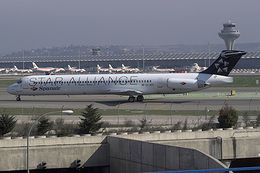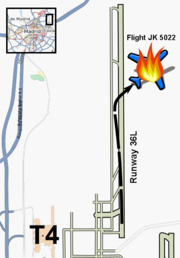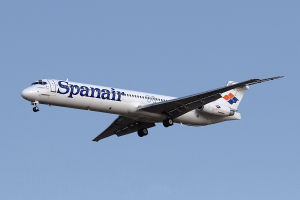Spanair Flight 5022
 EC-HFP "Sunbreeze" in its final Star Alliance livery |
|
| Fatal accident summary | |
|---|---|
| Date | 20 August 2008 |
| Type | Pilot error (Failure to extend flaps and slats for takeoff) |
| Site | Barajas Airport, Madrid, Spain |
| Passengers | 162 |
| Crew | 10 |
| Injuries | 18 |
| Fatalities | 154 |
| Survivors | 18 |
| Aircraft type | McDonnell Douglas MD-82 |
| Operator | Spanair |
| Tail number | EC-HFP |
| Flight origin | Barajas Airport |
| Destination | Gran Canaria Airport |
Spanair Flight JK 5022, from Barajas Airport in Madrid to Gran Canaria Airport in Gran Canaria, Spain, crashed just after take off from runway 36L of Barajas Airport at 14:25 CEST (12:25 UTC) on 20 August 2008. The aircraft was a McDonnell Douglas MD-82, registration EC-HFP. It was the first fatal accident for Spanair (part of the SAS Group) in the 20-year history of the company, and the 14th fatal accident and 24th hull loss involving MD-80 series aircraft. It was the world's deadliest aviation accident in 2008 and Spain's deadliest in 25 years.[1] 154 people died; six died en route to the hospital, one died overnight and one died in the hospital three days later. Only 18 people survived.[2][3]
Contents |
Crash

The aircraft, christened "Sunbreeze", registration EC-HFP,[4] (manufacturer's serial number 53148, Douglas line number 2142)[5] had been delivered to Korean Air on 18 November 1993 and was acquired by Spanair in July 1999. When it took off it was carrying a total of 172 people of which 162 were passengers, four deadheading crew members and six flight crew.[6]
The accident occurred at 14:25 local time, seconds after takeoff.[4][6][7] The aircraft rolled to the right,[8] and crashed in the vicinity of the runway, breaking into at least two parts which were engulfed by the subsequent explosion.
Spanair reported that the pilot had previously attempted and aborted a departure due to a sensor reporting excessive temperature in an air intake, and that the temperature sensor was de-activated on the ground (reportedly an established procedure since that sensor is redundant), delaying departure by over an hour.[9] Another takeoff was attempted, during which the fatal accident occurred.[10]
The flight was a Star Alliance codeshare operated on behalf of Lufthansa as LH 2554.[11] Seven passengers with Lufthansa tickets had reservations. Four of the Lufthansa passengers were from Germany.[12]
Casualties
Initial reports underreported the number of casualties. Of the 172 people on board, 146, including all crew members, perished in the crash or immediately after in the violent fire; of the 26 passengers rescued alive from the crash site, six died before arriving at the hospital, and two more in hospital, bringing the total number of fatalities to 154.[10][13][14][15][2][16]
According to government officials, at least 15 of the deceased were not Spanish, including at least five Germans, two French, a Mauritanian, a Turk, a Bulgarian, a Gambian, an Italian, an Indonesian and two Brazilians. Among the survivors were at least three non-Spanish citizens; a Swede, a Finn and a Bolivian.[17] A 30 year old woman with British and Spanish dual citizenship survived with no burns as she was flung from row 6, still attached to her seat, and landed in a nearby stream. She suffered a punctured lung and broken left arm. Because of this ejection, she did not receive burns that the majority of the other passengers suffered.[18]
Ervigio Corral, the head of the emergency services rescue team, said that the crash flung many of the survivors into a creek, lessening the severity of their burns.[19]
Investigation
Summary

A preliminary report on the accident was released by CIAIAC, the Civil Aviation Accident and Incident Investigation Commission, on 6 October[20]. Flight data recorders showed that the aircraft had taken off with flaps at 0°, and that the alarm for that abnormal takeoff configuration had not sounded. The report hinted at no other cause of the accident, and excluded both the engines and thrust reversers as causes of the accident.
On 17 August 2009, CIAIAC released an interim report on the incident [21]. The interim report confirmed the preliminary report's conclusion that the crash was caused by an attempt to take off with the flaps and slats retracted, which constituted an improper configuration, and noted that safeguards that should have prevented the crash failed to do so. The cockpit recordings revealed that the pilots omitted the "set and check the flap/slat lever and lights" item in the After Start checklist. In the Takeoff Imminent verification checklist the copilot just repeats the flaps and slats correct values without actually checking them, as shown by the physical evidence. All three safety barriers provided to avoid the takeoff in an inappropriate configuration were defeated: the configuration checklist, the confirm and verify checklist, and aircraft warning system (TOWS). The report also made a number of safety recommendations intended to prevent incidents like this from happening again.[22]
An internal report issued by the airline revealed that their central computer system used to monitor technical problems with the aircraft was infected with malware and may have prevented the detection of technical problems with the aircraft. A judge has ordered Spanair to provide all of the computer's logs from the days before and after the crash. The final report from crash investigators is not due to be presented until December, 2010.[23]
Representatives from the US National Transportation Safety Board, the aircraft manufacturer Boeing (as successor to McDonnell Douglas, the original aircraft manufacturer), and the engine manufacturer Pratt and Whitney are supporting the investigation.
Timeline
- 22 August 2008
Some early eye-witness accounts had suggested that the aircraft had suffered an engine fire or explosion before crashing, but the Spanish airport authority AENA released a video showing that the engines neither exploded nor caught fire during take-off.[24][25] Manuel Bautista, Director General of Spain's civil aviation authority, went as far as to state: "The engine is not the cause of the accident",[24] surmising that a chain of events combining together was more likely than a single cause.[26]
There has been considerable interest in the faulty air temperature probe that initially caused the pilot to turn the plane back for maintenance before its catastrophic takeoff attempt. The mechanic simply deactivated the probe because the aircraft's Minimum Equipment List allowed it to be left inoperative. On August 22 investigators interviewed the mechanic, who defended his action by saying that it had nothing to do with the crash. Spanair has supported the mechanic's view that deactivation of the probe is an accepted procedure.[27] On 1 September a report, quoting Spanair, stated that the problem detected on the first takeoff attempt was overheating caused by a temperature gauge's de-icing system, rather than a dysfunction of the temperature gauge itself and that since icing was not a risk on that flight, that the de-icing system had been deactivated by the mechanic with captain's approval.[28]
Aviation Week reported that the probe was a total air temperature sensor, located on the front of the aircraft near the cockpit.[29] The aircraft's computer uses total air temperature to help calculate the ambient air temperature, which in turn is needed to calculate the aircraft's true airspeed. True airspeed is needed for high altitude navigation, but is not so important for maintaining stable flight. Ground Speed is calculated directly from GPS position change (or Inertial navigation position change on earlier models). When TAS (true airspeed) is compared with Groundspeed, however, the actual wind direction and speed at that altitude can be calculated and presented to the pilot. Indicated airspeed, a measure of the relative wind over the aircraft's surfaces, is a more important measure for ensuring stable, safe flight. The aircraft's stall speed closely relates to indicated airspeed, for example.
- 25 August 2008
Reports suggested that investigators were focusing on the possibility that the thrust reverser of the No. 2 (right side) engine activated during the climb , since it was found to be in the deployed position in the wreckage. Indeed one of the photographs [1] released on the day of the accident appears to show a deployed reverser. If the reverser deployed during takeoff, and not as a result of impact, it has been suggested that the plane would have yawed suddenly to the right.[30] Since the MD-82 has tail-mounted engines, however, positioned quite close to each other, and close to the plane's longitudinal axis, the activation of a reverser may not have produced uncontrollable yaw, even though the situation may still have been critical.[31] Thrust reversers are normally employed just after touch down to reduce braking distances.[32] Evidence which has more recently come to light suggests that the aircraft took to the sky with a known pre-existing problem with one of its thrust reversers, which was the subject of a temporary "work around" to keep the aircraft operational.[33] On 7 September, El Mundo reported that the thrust reverser deployment was commanded after the crash, to bring the aircraft to a stop; the left reverser deployed normally, while the right one (with the pre-existing condition) did not. If this last suggestion is accepted, then the deployment of one or both thrust-reversers, deliberate or otherwise, would not appear to be the direct cause of the crash.
- 5 September 2008
El Mundo, citing a source in the investigation team, reported that the cockpit voice recorder showed that the pilot had said "Flaps OK, Slats OK" to the co-pilot.[34] The article confirmed that the flaps had not been extended and that the alarm for that condition had not sounded.[35]
In an article published on 7 September, El Mundo stated that during the flight preparation and takeoff attempts, the aircraft had some of its systems in flight mode rather than ground mode. If true, this might explain why de-icing of the Total Air Temperature probe activated on the ground, causing overheat, since in flight the heater would activate only when there was no air flow in the probe, a sign of icing. This might also explain why the flaps and slats alarm had not sounded, since this alarm is disabled in flight mode.[36][37]
The maintenance logbook of the airplane has comments, 2 days before the crash, for an "autoslats failure" visual alarm occurring on slats extension; however autoslats are not used on takeoff, and it can not be inferred that the slats system had a defect. The logbook also shows that overheating of the air temperature sensor occurred repeatedly the day before the crash.[38][39]
- 18 September 2008
The Spanish newspaper El País made available, on its website, a video capturing the crash [2] and which had been examined by the official investigating team. The video, from an airport security camera, showed the aircraft gaining very little altitude, returning to the ground, apparently just to the right of the runway, continuing forward for some distance beyond the end of the runway and then dropping into the river-bed and catching fire.
- 16 October 2008
The BBC reported that the judge investigating the crash was to question three mechanics on suspicion of manslaughter. These were the two mechanics who checked the plane before take-off and the head of maintenance for Spanair at Barajas.[40]
- 18 August 2009
- 11 May 2010
Details from the cockpit voice recoder were leaked to the public and released by Spanish media. The recording showed that both pilots were concerned about a repair job performed earlier the day of the crash, in which mechanics used an ice pack to cool an overheating temperature sensor and removed a fuse.[41]
- 20 Aug 2010
Spanish daily El Pais reports that malware which had infected the airline's central computer system resulted in a failure to raise an alarm over multiple problems with the plane. ([5]) ([6])
Similar accident
Failure to extend flaps and slats had caused an earlier MD-82 crash, Northwest Airlines Flight 255, where the plane had similarly failed to gain altitude, as noted early on by the investigators. In that accident the crew had similarly been disrupted from routine operation before the fatal takeoff, and the alarm similarly had not sounded. In that accident, however, examination of the alarm and its circuit breaker had not revealed any fault.[42][43] The Spanair interim report specifically mentions two other similar accidents, in addition to the Northwest 255 accident, Delta Air Lines Flight 1141, and Mandala Airlines Flight 091.[44]
See also
- V1 speed
- Runway safety area
- List of accidents and incidents involving commercial aircraft
- Northwest Airlines Flight 255
- LAPA Flight 3142
References
- ↑ Santafe, Elisa (2006-08-22). "Families struggle to face up to losses in Spain air disaster". Brisbane Times. http://www.brisbanetimes.com.au/news/world/families-struggle-to-face-up-to-losses-in-spain-air-disaster/2008/08/22/1219262462353.html. Retrieved 2008-08-22.
- ↑ 2.0 2.1 "Spanish plane that crashed had overheated valve". Associated Press. 2008-08-21. http://ap.google.com/article/ALeqM5iZGjqoRsHwCookXNzTtwupigxBRAD92MM2O00.
- ↑ "Madrid crash claims another life". BBC. 2008-08-23. http://news.bbc.co.uk/1/hi/world/europe/7579293.stm. Retrieved 2008-08-25.
- ↑ 4.0 4.1 Simon Hradecky (2008-09-16). "Crash: Spanair MD-82 at Madrid on 20 August 2008, went off runway during takeoff". http://avherald.com/h?article=40b73189/0017.
- ↑ "Picture of the McDonnell Douglas MD-82 (DC-9-82) aircraft". Airliners.net. http://www.airliners.net/photo/Star-Alliance-(Spanair)/McDonnell-Douglas-MD-82/1360214/M/. Retrieved 2008-08-22.
- ↑ 6.0 6.1 "Official notices for accident JK5022-20/08/06". Spanair. 2006-08-20. http://www.spanair.com/web/en-gb/Official-notices/Press-Release-3. Retrieved 2008-09-04.
- ↑ "¿A qué hora ocurrió exactamente el accidente?". El Mundo. http://www.elmundo.es/elmundo/2008/08/21/espana/1219342774.html. Retrieved 2008-08-22.
- ↑ "What caused the Madrid crash?". BBC. 2008-08-21. http://news.bbc.co.uk/2/hi/puffbox/hyperpuff/audiovideo/front_page_ukfs/wide_front_page_av_hyperpuff/7575607.stm. Retrieved 2010-01-04.
- ↑ Keeley, Graham (2008-08-20). "Madrid crash: 'The plane came to a sharp stop. I heard a horrible noise'". London: The Guardian. http://www.guardian.co.uk/world/2008/aug/21/spain1. Retrieved 2010-05-23.
- ↑ 10.0 10.1 "Many dead in Madrid plane crash". BBC News. 2008-08-20. http://news.bbc.co.uk/1/hi/world/europe/7572643.stm. Retrieved 2010-01-04.
- ↑ Spanair Press release Spanair Press release Retrieved 16:42 GMT 20th August 2008
- ↑ Spanair flight JK 5022 Lufthansa Press Release, Retrieved 20th August 2008, 18:24 UTC
- ↑ Brothers, Caroline; Maynard, Micheline (2008-08-20). "More Than 150 Die in Madrid Plane Crash". The New York Times. http://www.nytimes.com/2008/08/21/world/europe/21madrid.html?ref=world. Retrieved 2010-05-23.
- ↑ "147 killed in plane crash at Madrid airport". Associated Press. 2008-08-20. http://ap.google.com/article/ALeqM5iZGjqoRsHwCookXNzTtwupigxBRAD92M4MS00.
- ↑ "Death toll climbs in Spanair plane crash". UPI. 2008-08-20. http://www.upi.com/Top_News/2008/08/20/Spanair_plane_crash_kills_more_than_140/UPI-53011219241083/.
- ↑ "'Scene from Hell': More than 150 tourists burned alive as plane was ripped apart in runway fireball". Daily Mail. 2008-08-21. http://www.dailymail.co.uk/news/worldnews/article-1047380/Up-150-tourists-feared-killed-plane-breaks-crash-landing-Madrid-airport.html.
- ↑ "Pelo menos 14 mortos são estrangeiros, um deles brasileiro". TSF. 2008-08-21. http://tsf.sapo.pt/PaginaInicial/Internacional/Interior.aspx?content_id=982578.
- ↑ "British woman's incredible escape from doomed Madrid plane". Mirror Group Newspapers. 2008-08-24. http://www.mirror.co.uk/news/top-stories/2008/08/24/british-woman-s-incredible-escape-from-doomed-madrid-plane-115875-20708800/.
- ↑ "153 killed in Madrid airport plane crash". Reuters. http://www.reuters.com/article/topNews/idUSLK27234920080820?feedType=RSS&feedName=topNews. Retrieved 2008-08-22.
- ↑ "20-08-2008. EC-HFP. McDonnell Douglas MD-82. Aeropuerto de Barajas (Madrid). Preliminary report". CIAIAC. 2008-10-14. http://www.fomento.es/NR/rdonlyres/C58972BC-B96C-4E14-B047-71B89DD0173E/43303/PreliminaryReportA_032_2008.pdf. (Spanish version)
- ↑ "20-08-2008. EC-HFP. McDonnell Douglas MD-82. Aeropuerto de Barajas (Madrid). Interim report". CIAIAC. 2009-08-17. http://www.fomento.es/NR/rdonlyres/9AA08FE0-1151-41A0-9A57-9C5DF8BF6F8E/52877/2008_032_A_INTERINO_01_ENG1.pdf. (Spanish version) (Press release)
- ↑ "El informe de la tragedia de Spanair revela dos errores de los pilotos y un fallo técnico (in Spanish)". El País. 2009-08-17. http://www.elpais.com/articulo/espana/informe/tragedia/Spanair/revela/errores/pilotos/fallo/tecnico/elpepuesp/20090817elpepunac_3/Tes.
- ↑ "Malware implicated in fatal Spanair plane crash". TechNewsDaily. 2010-08-20. http://www.msnbc.msn.com/id/38790670/ns/technology_and_science-security/.
- ↑ 24.0 24.1 Keeley, Graham (2008-08-22). "Madrid air disaster video shows new light on cause of crash". London: The Guardian. http://www.guardian.co.uk/world/2008/aug/22/madrid.spain1?gusrc=rss&feed=networkfront. Retrieved 2008-08-22.
- ↑ "Madrid plane burst into flames after runway skid". 2008-08-22. http://edition.cnn.com/2008/WORLD/europe/08/22/plane.crash.madrid/index.html. Retrieved 2008-08-24.
- ↑ "'Chain of faults' in Madrid crash". BBC. 2008-08-22. http://news.bbc.co.uk/2/hi/europe/7577536.stm. Retrieved 2008-08-22.
- ↑ "Spanish mechanic who cleared doomed plane quizzed". Associated Press. 2008-08-23. http://www.iht.com/articles/ap/2008/08/23/europe/EU-Spain-Plane-Crash.php. Retrieved 2008-08-23.
- ↑ "Speculation over causes of Spanair crash". France 24. 2008-09-01. http://www.france24.com/en/20080901-speculation-over-causes-spanair-crash-spain-plane-crash-madrid.
- ↑ Flottau, Jens (2008-08-21). "Spanair Stands by MD-80 Fleet". Aviation Week. http://www.aviationweek.com/aw/generic/story.jsp?id=news/SENS08218.xml&headline=Spanair%20Stands%20By%20MD-80%20Fleet&channel=comm. Retrieved 2008-08-23.
- ↑ Hernández, José Antonio (2008-08-25). "La pérdida de potencia de los motores centra las pesquisas". El País. http://www.elpais.com/articulo/espana/perdida/potencia/motores/centra/pesquisas/elpepuesp/20080825elpepinac_1/Tes. Retrieved 2008-08-25.
- ↑ "Los motores están enteros y sin signos de haber sufrido incendio, según la investigación". ElMundo.es. 2008-08-26. http://www.elmundo.es/elmundo/2008/08/26/espana/1219735081.html. Retrieved 2008-08-26.
- ↑ "Triebwerk im Spanair-Jet war auf Umkehrschub geschaltet". Spiegel Online. 2008-08-26. http://www.spiegel.de/panorama/0,1518,574389,00.html. Retrieved 2008-08-26.
- ↑ Govan, Fiona (2008-08-28). "Spanish crash plane had known mechanical problem". London: Daily Telegraph. http://www.telegraph.co.uk/news/worldnews/europe/spain/2639738/Spanish-crash-plane-had-known-mechanical-problem.html. Retrieved 2008-08-29.
- ↑ "Los alerones del avión estrellado en Madrid no estaban activados (prensa)". AFP. http://afp.google.com/article/ALeqM5jmQhcrEox6otkY5j8VwtfDn7FoYg. Retrieved 2008-09-06.
- ↑ Bremner, Charles (2008-09-06). "Basic pilot error blamed for Spanair crash in Madrid that killed 154". London: TimesOnline. http://www.timesonline.co.uk/tol/news/world/europe/article4685414.ece. Retrieved 2010-05-23.
- ↑ "Las claves de la investigación del accidente del JK 5022 en Barajas". El Mundo. 2008-09-07. http://www.elmundo.es/elmundo/2008/09/06/espana/1220724555.html.
- ↑ "Spanair MD-82 crash inquiry battles to understand absent flap warning". Flight Global. 2008-09-16. http://www.flightglobal.com/articles/2008/09/16/316060/spanair-md-82-crash-inquiry-battles-to-understand-absent-flap-warning.html.
- ↑ "More faults revealed about fated Spanair plane". Typically Spanish. 2008-09-15. http://www.typicallyspanish.com/news/publish/article_18006.shtml.
- ↑ "blog post linking to leaked logbook summary". pprune.org. 2008-09-24. http://www.pprune.org/4418153-post2017.html.
- ↑ "Spanair mechanics face crash quizz". BBC. 2008-10-16. http://news.bbc.co.uk/1/hi/world/europe/7673316.stm. Retrieved 2010-01-04.
- ↑ "Last moments of doomed Spanair flight caught on tape". The Telegraph. 11 May 2010. http://www.telegraph.co.uk/news/worldnews/europe/spain/7710689/Last-moments-of-doomed-Spanair-flight-caught-on-tape.html. Retrieved 24 August 2010.
- ↑ Eddy, Paul (2008-08-24). "Spanair crash recalls 1987 Detroit disaster". London: TimesOnline. http://www.timesonline.co.uk/tol/news/world/europe/article4597009.ece. Retrieved 2010-05-23.
- ↑ "Aircraft Accident Report, Northwest Airlines 255" (PDF). NTSB. 1987-08-16. http://libraryonline.erau.edu/online-full-text/ntsb/aircraft-accident-reports/AAR88-05.pdf.
- ↑ "Interim Report A-032/1998". CIAIAC. p. 34. http://www.fomento.es/NR/rdonlyres/9AA08FE0-1151-41A0-9A57-9C5DF8BF6F8E/52877/2008_032_A_INTERINO_01_ENG1.pdf.
External links
Spanair
- Spanair Last Official Notice
- List of passengers (Spanish)
- Press release 1
- Press release 2
- Press release 3
Guardia Civil 08-18-2009
- Infographic
- Photos of the crashed airliner from AirDisaster.com
- Pre-crash photos of the airliner at airliners.net
NASA
CIAIAC
|
||||||||||||